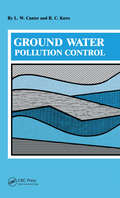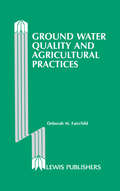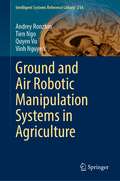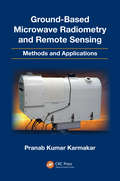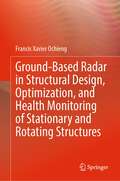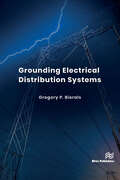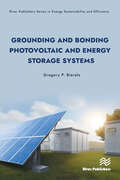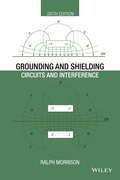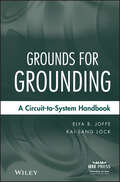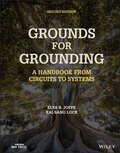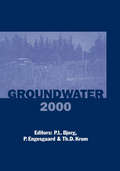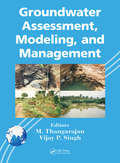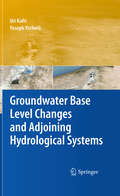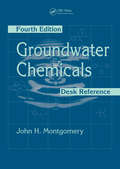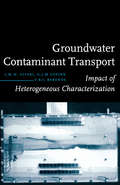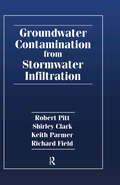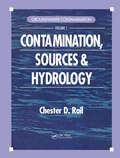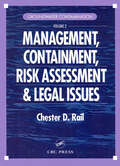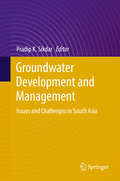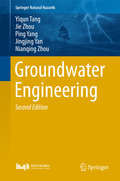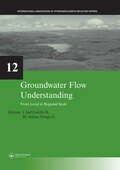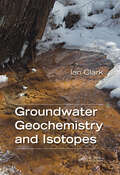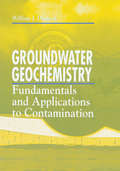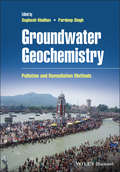- Table View
- List View
Ground Water Pollution Control
by L.W. CanterCovers thoroughly technologies for ground water pollution control in part one and deals in depth with aquifer restoration decision-making in part two. Part three gives an extensive range of case studies and detailed references.
Ground Water Quality and Agricultural Practices
by Deborah FairchildThis outstanding reference book deals with effects of various agricultural practices on ground water quality and usage; and ground water management strategies for protection of ground water affected by agriculture.
Ground and Air Robotic Manipulation Systems in Agriculture (Intelligent Systems Reference Library #214)
by Vinh Nguyen Andrey Ronzhin Tien Ngo Quyen VuProblems of joint application of heterogeneous ground and air robotic means while performing the agricultural technological tasks that require physical interaction with agricultural products and the environment are discussed in the book. Proposed solutions for the exchange of energy and physical resources of unmanned aerial vehicles on ground service platforms, automation of the process of collecting agricultural products and ensuring the stability of the air manipulation system at physical interaction with a ground object are important for the transport and agricultural industry robotization.The book addresses the researchers investigating interdisciplinary issues of agricultural production robotization, problems of information, physical and energy interaction of ground and air robots; recommended to postgraduates and students studying "Mechatronics and robotics" and "Technologies, mechanization and power equipment in agriculture, forestry and fisheries."
Ground-Based Microwave Radiometry and Remote Sensing: Methods and Applications
by Pranab Kumar KarmakarThe ability to effectively monitor the atmosphere on a continuous basis requires remote sensing in microwave. Written for physicists and engineers working in the area of microwave sensing of the atmosphere, Ground-Based Microwave Radiometry and Remote Sensing: Methods and Applications is completely devoted to ground-based remote sensing. This text
Ground-Based Radar in Structural Design, Optimization, and Health Monitoring of Stationary and Rotating Structures
by Francis Xavier OchiengThis book provides a practical application for using ground-based radar (GBR) as a remote (non-contact) sensor for structural health monitoring (SHM) in the development of sustainable and robust stationary and rotating structures, such as beam-like bridges, towers, wind turbines, and hydropower turbines. It integrates cutting-edge research into an easy-to-understand approach for non-radar and monitoring specialists, building on the methods and theory of working with radar systems, SHM frameworks, GBR signal processing, and validation techniques. All aspects of in-field monitoring and use during the design and testing of structures are covered, including data acquisition and processing, damage detection techniques, and damage prognostic techniques. The book is a hands-on reference that provides critical information on GBR for practitioners, university instructors, and students involved in structural design, optimization, and health monitoring of stationary and rotating structures.
Grounding Electrical Distribution Systems
by Gregory P. BieralsThe first concern and the most important reason for proper grounding techniques are to protect people from the effects of ground-faults and lightning. Creating an effective ground-fault current path to assure the operation of overcurrent protective devices on solidly grounded systems and to limit the voltage-rise on equipment frames during fault condition is of paramount importance. The next concern is building and equipment protection. In this case, providing low impedance bonding and grounding paths between the system source, the electrical service and downstream equipment will serve to limit hazardous voltages due to faults and especially, lightning, A low resistance-to-ground system will serve to limit the voltage rise on systems and equipment. But of equal importance is the length of the grounding electrode conductor. It is critical to limit the length of this conductor due to the increased impedance of lightning currents. And finally, a properly installed grounding system will minimize the effects of electrical noise on sensitive circuits and stabilize the voltage-to-ground during normal operation. This volume has extensive information on grounding electrical systems and equipment. This information includes the following topics: System Grounding Equipment Grounding Bonding The Grounding Electrode System Solidly Grounded Systems Impedance Grounded Systems Grounding Separately-Derived Systems Calculating Ground-Fault Currents Conductor Insulation Withstand Ratings Conductor Fusing or Melting Currents Functional Grounding Lightning Protection Readership: Anyone involved with designing a proper grounding system that will serve to protect people and equipment from the effects of ground faults and lightning. And to design a proper grounding system for special applications, including Solar and Wind Powered Systems.
Grounding and Bonding Photovoltaic and Energy Storage Systems (River Publishers Series in Energy Sustainability and Efficiency)
by Gregory P. BieralsThis book is designed for energy professionals to expand their understanding of proper grounding and bonding methods for photovoltaic (PV) and energy storage systems. While grounding and bonding are critical for any electrical distribution system, it is especially pertinent for PV systems due to the potential of high short circuit and ground-fault currents, as well as the possible and likely exposure to high magnitude and short duration lightning currents. This course will offer an in-depth exploration of these essential applications in the context of solar renewable and battery storage systems.This text includes an in-depth study of the terms and definitions applicable to grounding and bonding. In addition, there is a complete analysis of single-phase and three-phase distribution systems, beginning at the supply transformer and terminating at the utilization equipment supplied by a branch circuit. This summary includes the proper system and equipment grounding and bonding methods. In addition, the lightning protection system is explained in detail (NFPA 780).In the final chapter there is a 50 question quiz and an answer key to further enhance the reader’s understanding of this subject.
Grounding and Shielding: Circuits and Interference
by Ralph MorrisonAccessibility note: The mathematical expressions and schematic diagrams in this book are contained in images. They will not be accessible for readers who can not view images. Applies basic field behavior in circuit design and demonstrates how it relates to grounding and shielding requirements and techniques in circuit design This book connects the fundamentals of electromagnetic theory to the problems of interference in all types of electronic design. The text covers power distribution in facilities, mixing of analog and digital circuitry, circuit board layout at high clock rates, and meeting radiation and susceptibility standards. The author examines the grounding and shielding requirements and techniques in circuit design and applies basic physics to circuit behavior. The sixth edition of this book has been updated with new material added throughout the chapters where appropriate. The presentation of the book has also been rearranged in order to reflect the current trends in the field. Grounding and Shielding: Circuits and Interference, Sixth Edition: Includes new material on vias and field control, capacitors as transmission lines, first energy sources, and high speed designs using boards with only two layers Demonstrates how circuit geometry controls performance from dc to gigahertz Examines the use of multi-shielded transformers in clean-power installations Provides effective techniques for handling noise problems in analog and digital circuits Discusses how to use conductor geometry to improve performance, limit radiation, and reduce susceptibility to all types of hardware and systems Grounding and Shielding: Circuits and Interference, Sixth Edition is an updated guide for circuit design engineers and technicians. It will also serve as a reference for engineers in the semiconductor device industry.
Grounds for Grounding: A Circuit to System Handbook
by Elya B. Joffe Kai-Sang LockGrounding design and installation is critical for the safety and performance of any electrical or electronic system. Blending theory and practice, this is the first book to provide a thorough approach to grounding from circuit to system. It covers: grounding for safety aspects in facilities, lightning, and NEMP; grounding in printed circuit board, cable shields, and enclosure grounding; and applications in fixed and mobile facilities on land, at sea, and in air. It?s an indispensable resource for electrical and electronic engineers concerned with the design of electronic circuits and systems.
Grounds for Grounding: A Handbook from Circuits to Systems
by Elya B. Joffe Kai-Sang LockGROUNDS FOR GROUNDING Gain a comprehensive understanding of all aspects of grounding theory and application in this new, expanded edition Grounding design and installation are crucial to ensure the safety and performance of any electrical or electronic system irrespective of size. Successful grounding design requires a thorough familiarity with theory combined with practical experience with real-world systems. Rarely taught in schools due to its complexity, identifying and implementing the appropriate solution to grounding problems is nevertheless a vital skill in the industrial world for any electrical engineer. In Grounds for Grounding, readers will discover a complete and thorough approach to the topic that blends theory and practice to demonstrate that a few rules apply to many applications. The book provides basic concepts of Electromagnetic Compatibility (EMC) that act as the foundation for understanding grounding theory and its applications. Each avenue of grounding is covered in its own chapter, topics from safety aspects in facilities, lightning, and NEMP to printed circuit board, cable shields, and enclosure grounding, and more. Grounds for Grounding readers will also find: Revised and updated information presented in every chapter New chapters on grounding for generators, uninterruptible power sources (UPSs) New appendices including a grounding design checklist, grounding documentation content, and grounding verification procedures Grounds for Grounding is a useful reference for engineers in circuit design, equipment, and systems, as well as power engineers, platform, and facility designers.
Groundwater 2000: Proceedings of the International Conference on Groundwater Research, Copenhagen, Denmark, 6-8 June 2000
by Poul L. Bjerg Peter Engesgaard Thomas D. KromThese proceedings, with cd-rom, present a comprehensive overview of advances in groundwater research. The five main topics covered are: aquifers and contaminant distribution; groundwater quality; natural attenuation; remediation technologies and groundwater protection. Groundwater 2000 is a useful resource to both scientists and to those working in the field.
Groundwater Assessment, Modeling, and Management
by Vijay P. Singh M. ThangarajanYour Guide to Effective Groundwater Management Groundwater Assessment, Modeling, and Management discusses a variety of groundwater problems and outlines the solutions needed to sustain surface and ground water resources on a global scale. Contributors from around the world lend their expertise and provide an international perspective on groundwater management. They address the management of groundwater resources and pollution, waste water treatment methods, and the impact of climate change on groundwater and water availability (specifically in arid and semi-arid regions such as India and Africa). Incorporating management with science and modeling, the book covers all areas of groundwater resource assessment, modeling, and management, and combines hands-on applications with relevant theory. For Water Resource Managers and Decision Makers The book describes techniques for the assessment of groundwater potential, pollution, prevention, and remedial measures, and includes a new approach for groundwater modeling based on connections (network theory). Approximately 30 case studies and six hypothetical studies are introduced reflecting a range of themes that include: groundwater basics and the derivation of groundwater flow equations, exploration and assessment, aquifer parameterization, augmentation of aquifer, water and environment, water and agriculture, the role of models and their application, and water management policies and issues. The book describes remote sensing (RS) applications, geographical information systems (GIS), and electrical resistivity methods to delineate groundwater potential zones. It also takes a look at: Inverse modeling (pilot-points method) Simulation optimization models Radionuclide migration studies through mass transport modeling Modeling for mapping groundwater potential Modeling for vertical 2-D and 3-D groundwater flow Groundwater Assessment, Modeling, and Management explores the management of water resources and the impact of climate change on groundwater. Expert contributors provide practical information on hydrologic engineering and groundwater resources management for students, researchers, scientists, and other practicing professionals in environmental engineering, hydrogeology, irrigation, geophysics, and environmental science.
Groundwater Base Level Changes and Adjoining Hydrological Systems
by Uri Kafri Yoseph YechieliThe proposed book deals with the role of changing groundwater base level on the adjacent hydrological systems. It summarizes, compiles and compares results of current and paleo base levels, using examples from all over the world. A classification is given for marine or continental groundwater base levels with special attention to those below sea level. The factors controlling base level changes and the methods for their determination are elaborated. Holocene and future changes are discussed with their effect on salinization and flushing mechanisms of groundwater. All topics described in the book are accompanied by examples and references from all over the world.
Groundwater Chemicals Desk Reference
by John H. MontgomeryUsing a clear and consistent format, this fourth edition contains more than 1,700 additional references and additional adsorption data for more than 800 organic compounds and metals, Henry's Law constants for 1,850 compounds, aqueous solubility data for over 2,500 compounds, toxicity data for 1,100 compounds, more than 31,000 synonyms, and 2,224 degradation products cross-referenced to parent compounds. Additional organic and inorganic solubilities, conversion factors, octanol-water partition coefficients, environmental fate data, analytical test methods, dielectric properties of various materials and liquids, and other tables and indexes have been added along with references for numerous physical parameters.
Groundwater Contaminant Transport: Impact of heterogenous characterization: a new view on dispersion
by F.B.J. BarendsImpacts of developed tools of heterogenous characterization on the hydrodynamics of flow and the transport mechanisms are illustrated in this text through a series of extensive numerical simulations consisting of single and multiple-realizations (Monte Carlo method).
Groundwater Contamination from Stormwater Infiltration
by Richard Field Robert E. Pitt Shirley Clark Keith ParmerGroundwater Contamination from Stormwater Infiltration examines topics such as urban runoff, constituents of concern, treatment, combined sewage characteristics, relative contributions of urban runoff flow phase, salts and dissolved minerals, treatment before discharge, outfall pretreatment, and local pretreatment.
Groundwater Contamination, Volume I: Sources and Hydrology
by Chester D. RailFully updated and expanded into two volumes, the new edition of Groundwater Contamination explains in a comprehensive way the sources for groundwater contamination, the regulations governing it, and the technologies for abating it. Volume 1 covers all major contaminants and explains the hydrology and data used to determine the extent of pollution.
Groundwater Contamination, Volume II: Management, Containment, Risk Assessment and Legal Issues
by Chester D. RailFully updated and expanded into two volumes, the new edition of Groundwater Contamination explains in a comprehensive way the sources for groundwater contamination, the regulations governing it, and the technologies for abating it. This volume discusses aquifer management and strategies for stormwater control and groundwater restoration. A number o
Groundwater Development and Management: Issues And Challenges In South Asia
by Pradip K. SikdarThis book deals with the challenges for efficient groundwater management, with a focus on South Asia and India, providing a balanced presentation of theory and field practice using a multidisciplinary approach. Groundwater of South Asia is increasingly confronted with overuse and deteriorating quality and therefore requires urgent attention. Management of the stressed groundwater systems is an extremely complex proposition because of the intricate hydrogeological set-up of the region. Strategies for sustainable management must involve a combination of supply-side and demand-side measures depending on the regional setting and socio-economic situations. As a consequence, the challenges of efficient groundwater management require not only a clear understanding of the aquifer configuration, but also demand for the development of a comprehensive database of the groundwater occurrences and flow systems in each hydrogeological setting. In addition, drilling and well construction methods that are appropriate to different hydrogeological formations need to be implemented as well as real-time monitoring of the status of the groundwater use. Also corrective measures for groundwater that is threatened with depletion and quality deterioration need to be installed. Finally, the legal framework of groundwater needs to be rearticulated according to the common property aspect of groundwater. These challenges should revolve around effective groundwater governance by creating an atmosphere to support and empower community-based systems of decision-making and revisit the existing legal framework and groundwater management institutions by fostering community initiatives.This book is relevant for academics, professionals, administrators, policy makers, and economists concerned with various aspects of groundwater science and management.
Groundwater Engineering
by Ping Yang Jingjing Yan Yiqun Tang Jie Zhou Nianqing ZhouIntegrating information from several areas of engineering geology, hydrogeology, geotechnical engineering, this book addresses the general field of groundwater from an engineering perspective. It covers geological engineering as well as hydrogeological and environmental geological problems caused by groundwater engineering. It includes 10 chapters, i. e. , basic groundwater theory, parameter calculation in hydrogeology, prevention of geological problem caused by groundwater, construction dewatering, wellpoint dewatering methods, dewatering wells and drilling, groundwater dewatering in foundation-pit engineering, groundwater engineering in bedrock areas, numerical simulation in groundwater engineering, groundwater corrosion on concrete and steel. Based on up-to-date literature, it describes recent developments and presents several case studies with examples and problems. It is an essential reference source for industrial and academic researchers working in the groundwater field and can also serve as lecture-based course material providing fundamental information and practical tools for both senior undergraduate and postgraduate students in fields of geology engineering, hydrogeology, geotechnical engineering or to conduct related research.
Groundwater Flow Understanding: From Local to Regional Scale (IAH - Selected Papers on Hydrogeology)
by J. Joel Carrillo R M. Adrian Ortega GThis book discusses integral groundwater management with scale flow issues and presents methods for defining, preventing, controlling, and mitigating negative environmental impacts related to groundwater. It highlights specific issues such as trans-boundary groundwater flow, groundwater recharge, groundwater mining, and groundwater flow in thick aquifers, and stresses the importance of the sustainable development of groundwater and its social and economic implications. The book will interest groundwater researchers, professionals, and students, providing new insights into the procedures and processes that are influenced by the scale of the groundwater flow system.
Groundwater Geochemistry and Isotopes
by Ian ClarkThere remains a lack of understanding of environmental isotopes and their use; students and practitioners typically find the concepts of isotope concentrations and partitioning to be more complicated than for geochemistry. However, this need not be so, if the basics are presented together with geochemistry, using case studies and examples to make the point. This new book presents the basics of environmental isotopes and geochemistry together, with case studies and simple examples that build a real understanding of their use in natural and contaminated groundwater.
Groundwater Geochemistry: Fundamentals and Applications to Contamination
by Randy Siegel William J. DeutschGroundwater Geochemistry: Fundamentals and Applications to Contamination examines the integral role geochemistry play s in groundwater monitoring and remediation programs, and presents it at a level understandable to a wide audience. Readers of all backgrounds can gain a better understanding of geochemical processes and how they apply to groundwater systems.The text begins with an explanation of fundamental geochemical processes, followed by a description of the methods and tools used to understand and simulate them. The book then explains how geochemistry applies to contaminant mobility, discusses remediation system design, sampling program development, and the modeling of geochemical interactions. This clearly written guide concludes with specific applications of geochemistry to contaminated sites.This is an ideal choice for readers who do not have an extensive technical background in aqueous chemistry, geochemistry, or geochemical modeling. The only prerequisite is a desire to better understand natural processes through groundwater geochemistry.
Groundwater Geochemistry: Pollution and Remediation Methods
by Pardeep Singh Sughosh MadhavThis book contains both practical and theoretical aspects of groundwater resources relating to geochemistry. Focusing on recent research in groundwater resources, this book helps readers to understand the hydrogeochemistry of groundwater resources. Dealing primarily with the sources of ions in groundwater, the book describes geogenic and anthropogenic input of ions into water. Different organic, inorganic and emerging contamination and salinity problems are described, along with pollution-related issues affecting groundwater. New trends in groundwater contamination remediation measures are included, which will be particularly useful to researchers working in the field of water conservation. The book also contains diverse groundwater modelling examples, enabling a better understanding of water-related issues and their management. Groundwater Geochemistry: Pollution and Remediation offers the reader: An understanding of the quantitative and qualitative challenges of groundwater resources An introduction to the environmental geochemistry of groundwater resources A survey of groundwater pollution-related issues Recent trends in groundwater conservation and remediation Mathematical and statistical modeling related to groundwater resources Students, lecturers and researchers working in the fields of hydrogeochemistry, water pollution and groundwater will find Groundwater Geochemistry an essential companion.
Groundwater Geophysics in Hard Rock
by Prabhat Chandra ChandraIn hard rock terrain, shallow water wells generally have a poor to moderate yield. Sinking wells deeply to tap yielding fracture zones often backfires, because the borehole may miss the saturated fracture zones at depths. A wrong approach to groundwater exploration in hard rock has therefore often led to unnecessary recurring expenditures and waste
